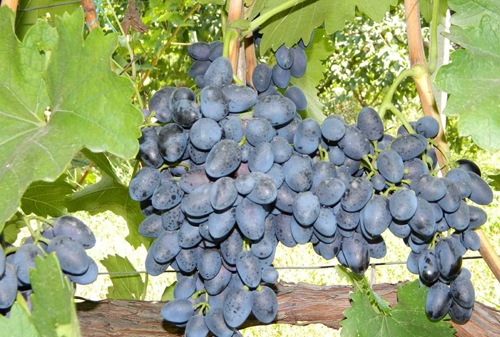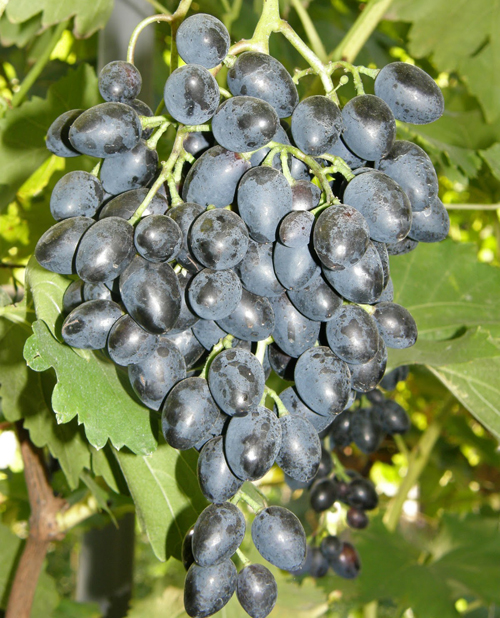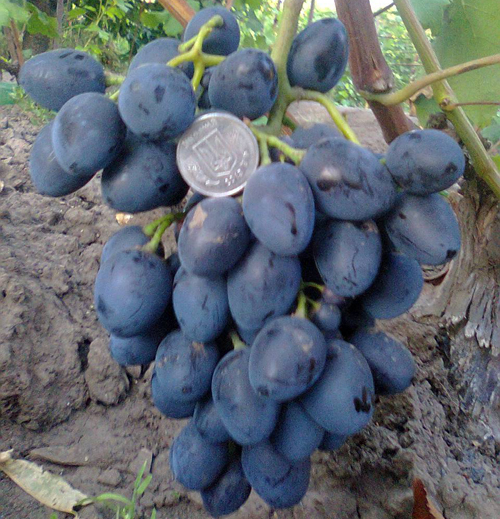Grape variety Nadezhda AZOS
Accustomed to loud amateur grape novelties that have appeared in large quantities in recent years and amaze the imagination with a variety of shapes and colors of berries, we undeservedly forget about time-tested grape varieties of traditional selection. But behind their appearance is the work of numerous teams of scientists, and it would be naive to think that all of them were less professional and productive than modern single breeders. Of course, research institutes do not issue a dozen new "varieties" a year, as many amateurs do, for whom such fertility is a vital necessity and an opportunity to earn money to do what they love. However, the varieties of traditional breeding, unlike their amateur counterparts, as a rule, have significantly higher genetic resistance, resistance to unfavorable factors and general stability in development and fruiting. Some of them have become real masterpieces of domestic breeding science, in terms of the totality of their characteristics, they significantly surpass many newfangled hybrid forms.

One of them is, we can already say that it is "old", but, nevertheless, still popular among many connoisseurs of Nadezhda AZOS. This variety of grapes began its life path in the 70s of the last century at the Anapa zonal experimental station, where it was bred by the breeder Nadezhda Nikitichnaya Apalkova, for which it received the corresponding name. Only in the early 90s, the variety was submitted for a state test, which successfully passed, and since 1998 it has been included in the State Register of Breeding Achievements of the Russian Federation approved for use. Grapes are zoned for the North Caucasian region (the Republic of Ingushetia, North Ossetia-Alania, Dagestan, Crimea, Adygea, Kabardino-Balkarian and Chechen, Stavropol and Krasnodar Territories, Rostov Region), however, it is common among amateur winegrowers far beyond its borders.
Famous parents of Nadezhda AZOS became Moldova and Cardinalwho passed on to their "daughter" almost all of their most positive qualities. Comprehensive resistance to fungal diseases, general unpretentiousness and extremely high yields were inherited from Moldova, while Cardinal improved the taste of the new hybrid form and provided a significantly shorter growing season than was inherent in Moldova. As a result, the new variety acquired a balanced set of positive qualities, which ensured its long life and popularity among admirers, even in conditions of the fiercest competition with "pop" hybrids.

Agrobiological characteristics of the variety
The grape bushes are characterized by high vigor of growth, Nadezhda AZOS actively grows wood and forms powerful perennial vines. The leaves are very large, rounded or extended in width, five-lobed, moderately dissected, reticulate-wrinkled above, covered with dense cobweb pubescence below. The edge of the leaf is strongly indented, the denticles are large, triangular, unequal in size, with sharp tops and a middle base. The lateral notches are of medium depth, the upper ones are often closed with a narrow elliptical lumen, the lower ones are open, vaulted with a rounded or flat bottom. The petiole notch is open, lyre-shaped, with a flat-pointed bottom. The petiole is short, a tone darker than the leaf blade. The flowers are bisexual, well pollinated with their own pollen, however, in years with unfavorable weather for flowering, pea berries may appear. A characteristic feature of the variety is its late flowering, which protects the inflorescences from recurrent spring frosts.
Bunches of grapes grow very large, the average weight is in the range of 500-600 grams, but the most massive ones reach two or more kilograms.The shape, as a rule, is broadly conical or branched, the density of the bunch is loose, due to which the berries in the brush are not deformed. The comb is powerful, sturdy, strong enough to hold even the most gigantic bunches. The berries of Nadezhda AZOS are large, oval with a pointed tip, black in color with a thick gray waxy bloom on the surface. Their average dimensions are 28 × 20 mm, and their weight is 6-7 grams. The pulp is of moderate density, quite juicy, crispy, yellowish-green in color. The taste is harmonious, sweet and sour, slightly tart if not picked late enough. Fully ripe berries do not have astringency The skin is thin and elastic, but at the same time, it is quite strong and edible. The seeds are available in the amount of 2-3 pieces, they are well separated from the pulp and, in general, do not spoil the taste experience too much when eating berries. Grape tasting score - 8.2 points. Ripe brushes of this variety can hang on the bushes for a long time without being damaged by wasps and rot, but it must be borne in mind that a sharp change in soil moisture due to heavy rains can lead to cracking of berries and their loss of presentation.

The crop is intended for fresh consumption, and is also quite suitable for home preservation. The strong skin and dense pulp of the berries determine the high indicators of transportability and suitability for long-term storage. With careful cleaning and placing the collected bunches in cool dry rooms in one layer on a straw bed, it is quite possible to keep them until December. Given the high price of grapes during this period, Nadezhda AZOS may be very attractive for winegrowers planning to grow it commercially.
The onset of removable maturity in this variety is early-medium. This means that the bunches will be ready for harvesting after 120-130 days of growing season, counting from the moment the buds open. The sum of active temperatures, the minimum required for ripening, is 2600-2700 ° C. With such indicators in the open field, the variety can be grown up to the latitude of cities such as Orel, Tambov or Lipetsk. Physiologically, Nadezhda AZOS is able to grow to the north, but at the same time the harvest will not reach those conditions that are potentially embedded in its genes. The frost resistance of the plant is average, without significant damage it can withstand temperatures down to -22 ° C. The yield is high. On average, in large tracts, up to 160 c / ha are obtained, and individual bushes, with proper and high-quality care, can produce more than 10-15 kilograms of grapes. Plants form up to 90% of fruiting shoots, and 2-3 bunches are laid on them, which is a very high indicator and requires rationing of the yield in order to prevent overloading of the bushes. By the onset of autumn frosts, the shoots ripen well and to their full length. Sugar accumulation in the variety is moderate - about 15-17 grams / 100 cubic meters. cm, acidity 7-8 grams / liter. The ratio is quite acceptable for canteens that do not pretend to have a dessert taste.
Agrotechnical features
In terms of cultivation technology, Nadezhda AZOS is a fairly convenient, unpretentious and plastic variety. It works on completely different types of soils. Does not require increased attention to itself. Possesses sufficient resistance to such harmful diseases as mildew and gray rot, and increased to powdery mildew. During the growing season, a few preventive spraying with fungicides is enough in order to keep these diseases under control. Grapes are not afraid of pests that could harm the ripe crop, such as wasps and leaf rollers. The only ones worth paying close attention to are the birds, which can make devastating raids on the vineyard.
At the same time, this variety also has features that should not be overlooked when growing. So, you should know that cuttings of Nadezhda AZOS take root hard, and therefore it should be propagated by grafting onto a better rooting and phylloxera-resistant stock. The variety shows good affinity with most of these rootstocks.
Also, due to the not very high frost resistance of the vine, the formation of bushes on a trunk in a non-covering culture is possible only in the very south, where there is no risk of a decrease in winter temperatures below -22 ° С. In other regions, you will have to take care of the shelter of the vine, choosing accordingly the methods of guiding the bush that facilitate this procedure - a multi-arm fan or an oblique cordon. Depending on the strength of the frosts, they are also determined with the thickness of the covering layer, which can be both light single and serious two-layer. Organic materials are traditionally used as insulation - straw, sawdust, reed mats and even leaves. From above, everything is covered with a layer of film or roofing material in order to prevent the vine from getting wet and the eyes of the grapes drying out in winter.
Certain efforts must be made to regulate the load on the bushes in order to find a middle ground, having received a bountiful high-quality crop and not undermining the vitality of the plants themselves. To do this, in the spring, the bushes are pruned moderately, leaving 30-40 eyes with a short length of fruit arrows (3-4 buds). After the beginning of the growing season, remove all sterile and weak shoots, as well as "twins" and "tees" growing from one bud. On fertile shoots during flowering, all bunches are removed except one, and only on the strongest of them two clusters are left. I must say that Nadezhda AZOS nevertheless allows some overload without serious consequences for itself, however, of course, you should not abuse this ability of the variety. During ripening, the bunches are lightened by removing the leaves around. Thanks to this, air exchange improves, and the berries are illuminated for more time by the rays of the sun, which is an additional prevention of fungal diseases and has a beneficial effect on the accumulation of glucose and fructose in grapes.








